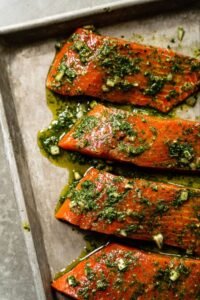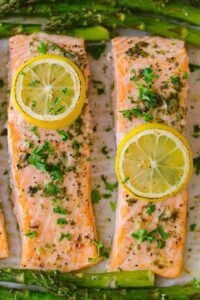Introduction to Tuna Steaks in the Air Fryer
Want a delicious, nutritional lunch in a matter of twinkles? Your new favorite might be air- fried tuna steak. This fashion uses lower oil painting, preserves the fish’s tenderheartedness, and cinches in tastes. It has the ideal balance of juicy agreeableness on the inside and crisp texture on the outside. This simple air range form will change the way you eat tuna, anyhow of whether you’re a seafood sucker or just trying out new cuisine ways. Take a look at how easy and succulent air- fried tuna steak can be!
Benefits of Cooking Tuna in the Air Fryer
Air toasters use high- speed hot air rotation, which culinarians food briskly than traditional styles. Tuna steaks, which do n’t need important cuisine time, are done in just many twinkles in the air range. This makes it a perfect option for busy weeknights or when you need a quick yet satisfying mess.
Healthier Cooking with Less Oil
Air frying requires minimum to no oil painting, making it a healthier choice compared topan-frying or deep- frying. Tuna is formerly a spare source of protein, so using the air range keeps the dish light and low in added fats, ideal for those watching calorie input or looking for a heart-healthy option.

Enhanced Flavor and Texture
The air range’s rapid-fire cuisine process locks in humidity, giving you a tender, juicy innards while creating a slightly crisp surface. This discrepancy in texture makes air- fried tuna steaks deliciously satisfying, with a seared finish that enhances flavors without overpowering the natural taste of the fish.
Even Cooking for Perfect Doneness
Achieving the right doneness with tuna steak can be tricky, especially since its culinarians snappily. The air range provides indeed heat distribution, helping you avoid overcooked edges and raw centers. With a little practice, you can constantly get tuna steaks just the way you like them — whether that’s rare, medium-rare, or completely cooked.
Less Odor and Mess
Air frying lowers splattering and the questionable smell when compared to stovetop cuisine. This leaves your kitchen smelling great and greatly simplifies remittal. also, thenon-stick air range handbasket makes remittal easier, allowing you to enjoy your regale without having to spend time subsequently drawing a visage.
Versatility for Different Flavors
A variety of coatings, gravies, and seasonings work nicely in the air range. From a introductory swab and pepper irk to further intricate gravies, you can try a variety of flavors. You may snappily change the flavors in the air range, allowing you to experiment with different combinations every time.
Selecting the Perfect Tuna Steak
When cooking in the air range, opting the proper tuna steak is essential to getting a soft, delicious finish. This composition will help you in choosing decoration tuna so that your mess always comes out faultlessly.

Types of Tuna for Steak
One of the most common kinds of tuna for steaks is yellowfin (Ahi) tuna. It’s perfect for frying in the air range because of its firm texture and mild flavor. In addition, it’s extensively accessible and generally less precious than other types. Bluefin Tuna Preferred in upmarket cuisine due to its rich, caloric flavor. It can be cooked to produce a luxurious, decadent supper, but it’s generally more expensive and eaten raw in dishes like sashimi. Albacore Tuna Albacore can be bought as fresh steaks, still it’s generally employed for canned tuna.
Color and Freshness
Color Depending on the type, decoration tuna should be bright, deep red or pink in tinge. Steaks of tuna that appear pale, brownish, or dull should be avoided since they could be signs that the fish is n’t fresh. Smell The aroma of fresh tuna should be crisp and noiselessly navigational. It should n’t smell explosively of fish, as this could be a sign of aging or indecorous storehouse. To guarantee newness, look for a vacuum- sealed packaging when copping prepackaged tuna.
Thickness of the Tuna Steak
Aim for a steak that’s between 1 and 1.5 elevation thick for invariant cuisine in the air range. While thinner steaks may overcook more fleetly, thicker steaks may be more delicate to cook completely without drying off the top. still, a 1, If you want your tuna rare or medium- rare.5- inch thicker steak will have seared outside and kindly raw innards. acclimatize cuisine times to your asked position of doneness.
Fresh vs. Frozen Tuna
Fresh Tuna Due to its flavor and texture, fresh tuna is generally favored. Check your neighborhood fish request or a respectable supermarket with a clean seafood area for tuna. Frozen Tuna If you’re searching for convenience, firmed tuna steaks are also a great choice. To maintain newness, numerous frozen tuna steaks are flash- firmed as soon as they’re captured. To guarantee invariant results in the air range, make sure to fully thaw firmed tuna in the fridge before cuisine.
Sourcing and Sustainability
Opting sustainable results is pivotal because tuna is constantly overfished. In general, pole- caught or line- caught tuna is more environmentally friendly than large- scale net fishing, so look for it. instruments for sustainably attained seafood are offered by groups similar as the Marine Stewardship Council (MSC). To make a more environmentally friendly decision, look for instruments like the MSC blue emblem.
Considerations for Different Diets
Wild-Caught vs. Farmed The texture and flavor of wild- caught tuna varies from that of tended tuna, which is generally slender. Wild- caught is generally seen to be more natural and healthier. Mercury Content Higher attention of mercury can be set up in tuna, particularly larger species like bluefin. Choose lower- mercury tuna, similar as albacore, or eat tuna sparingly if you’re mercury sensitive or if you’re furnishing it to youths or expectant maters.

Essential Ingredients and Seasonings
The proper constituents and seasonings are the first step in making a delicious air- fried tuna steak. In order to ameliorate the flavor and texture of your tuna steak, this section discusses the necessary constituents, suggested seasonings, and condiment options.
Main Ingredients
Tuna Steak For stylish results in the air range, elect fresh or fused tuna steaks that are between 1 and 1.5 elevation thick. Because of their rich flavor and strong texture, tuna species including bluefin and yellowfin(ahi) are excellent selections. oil painting (olive or avocado oil painting) Air toasters do n’t need important oil painting, but a thin subcaste helps make the tuna look crisp. While avocado oil painting’s high bank point makes it perfect for high- heat cuisine, olive oil painting is a popular volition due to its flavor. About 1 tablespoon is all you need for each steak.
Optional Marinade Ingredients
Tuna can retain its tenderheartedness and develop a deeper flavor by marinating it before cooking. Then are roughly well- liked condiment choices to consider Soy sauce Enhances the natural flavors of the fish and adds a hint of umami. It works well for gravies with an Asian faculty. Lemon or Lime Juice A little citrus juice brightens the fish and makes it softer. Use cautiously because too important acid can beget the fish to cook a little. Garlic Tuna goes well with the sweet touch that diced garlic brings. The stylish garlic is fresh, but if you like a softer taste, garlic greasepaint can also be used.
Dry Rubs and Seasonings
Traditional seasonings include Swab, black pepper, and paprika for a hint of smokiness. A mix of paprika, cayenne pepper, onion greasepaint, garlic greasepaint, and thyme is known as Cajun or Blackened seasoning. When cooked, this gives it a deeper color and a kick of spice that’s evocative of the South. Herb Blend for a Mediterranean touch, tuna goes nicely with dried sauces like basil, thyme, and rosemary. For added taste, squeeze in a little bomb tang.
Finishing Touches
Lemon Wedges A quick and easy approach to add brilliance right before eating is to serve tuna steak with fresh bomb wedges. Squeezing a bomb improves the flavor overall and adds acidity. Fresh Sauces An awful trim that adds color and a burst of flavor is diced cilantro, parsley, or chives. Sesame Seeds To add texture and a nutty taste, smatter sesame seeds over the tuna either before cooking or as a trim for an Asian twist.
Sauce Options for Serving
Soy sauce, gusto, garlic, and a little honey are combined to make soy gusto glaze. To make a glaze, poach these constituents until they come kindly thicker. Wasabi Mayo To make a racy, delicate dipping sauce, combine mayonnaise with a bitsy bit of wasabi paste. Citrus Vinaigrette For a mild, salty dressing, blend bomb or orange juice with olive oil painting, swab, and pepper. Teriyaki Sauce When combined with Asian- inspired constituents, the sweet and savory teriyaki glaze delivers a scrumptious explosion.
Tips for Applying Seasonings
Pat the Tuna Dry Use paper apkins to stroke the tuna dry before using any condiment or dry seasoning. This guarantees a friable finish and improves the adhesion of the spices. Apply oil painting Last After the seasonings, smoothly oil painting the tuna steak if you’re using a dry irk. This keeps the irk from burning in the air range and helps it stick. Steer clear of overpowering flavors Seasonings should be used to accentuate rather than cover the rich, meaty flavor of tuna. Start with a bitsy volume and change it according to your preferred flavor.

Conclusion
One easy, nutritional, and tasteful way to eat this adaptable fish is to cook tuna steak in an air range. You may constantly get an impeccably cooked, tender, and delicious steak by opting the applicable tuna, exercising complimentary seasonings, and according to many essential cuisine guidelines. The air range is a great choice for stunning feasts or quick weekday refections because it not only expedites the procedure but also produces a crisp face without using a lot of oil painting. Air- fried tuna steak offers innumerous options, whether you like a traditional swab- and- pepper irk, a condiment with Asian influences, or a strong Cajun seasoning. Try it out and enjoy eatery- quality results in the convenience of your own kitchen.
